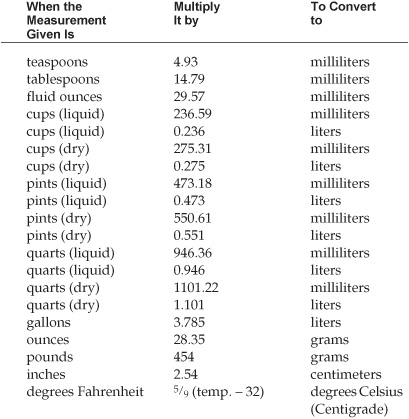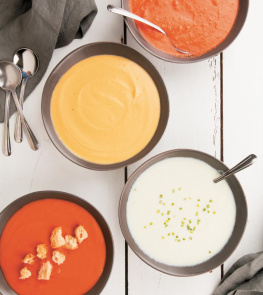Of the more than 3,000 varieties of tea (not including herb teas), all begin with the dried leaves of one plant: Camellia sinensis, a species grown throughout Asia. The leaves of Camellia sinensis develop slightly different tastes depending on the soil, climate, and elevation of the site of its cultivation, resulting in an amazing variety of tea flavors. When harvested, dried, and processed, these leaves become what is collectively known as black tea. Tea names often indicate geographic origin: Assam is a province in northern India, Ceylon tea comes from Sri Lanka, and Darjeeling is a district in the foothills of the Himalayas.
Herbal tea is made by steeping the leaves, stems, flowers, or roots of that large group of flavorful plants known as herbs. Some of these plants have documented medicinal properties, and herb teas have a long tradition as healing drinks. Herb teas also contain no caffeine, contributing to their healthful reputation. But if you think of herb tea only for its medicinal value, you are missing a lot of tea pleasure. Whereas all types of black tea fall on one taste spectrum, herb teas give us a full rainbow of flavors.
Commercial manufacturers of herb tea have developed many delicious and winsomely named concoctions. These range from wholly herbal combinations to blends of herb and black teas. (If the package says caffeine-free, its an all-herbal blend.)
If you grow herbs in your garden, you can enjoy making your own tea blends. But even if you dont, you can experiment by adding commercially available herb products such as anise, fennel, and caraway seed to regular tea.
Rosy Sugar
Sugar flavored with the seductive fragrance of roses is doubly sweet; it makes an ordinary cup of tea something extraordinary. Layer petals from unsprayed roses with sugar in a jar that closes tightly; after a few weeks, sift out the petals. Store sugar in a covered container.
Spiced Tea
Experiment with the many wonderful tea blends offered by commercial tea companies and then, the next time youre in the supermarket, scoot over to the spice aisle and the produce section and buy the ingredients whole cinnamon, cloves, allspice, and nutmeg, for example to make your own spiced tea. Dont use powdered spices they leave a gritty residue. The process of making spiced tea is simplicity itself: Put a small amount of spices (use just one or a favorite combination) right in the teakettle with the water; by the time the water boils, some of their flavor will be extracted into your tea.
Healing Teas
The medicinal value of certain herbs is well established; tea brewed from them is healing as well as soothing. There are many traditionally favorite herbal combinations for these teas use individually or mix and match the herbs in the following lists to find a flavor that suits you.
For colds and sore throats, try:
hyssop
peppermint
lemon balm
sage
echinacea
For indigestion, try:
peppermint
fennel
gentian
anise
For cramps, try:
peppermint
hops
red raspberry leaves
For tension or stress, try:
chamomile
wood betony
linden flower
California poppy
passionflower
valerian

Great Tea Recipes
Making tea is a simple task with greatly enjoyable results. Tea leaves release their flavor in water the hotter the water, the faster the tea steeps. Brewing with boiling water takes 5 minutes, sun tea can take an hour, and refrigerator tea takes several hours.
Hot Tea
Hot tea is making a comeback from the classical era, now rivaling coffee as the favored hot beverage of the populace. Whether its a stiff cup of Irish Breakfast first thing in the morning or a soothing cup of chamomile in the evening, a hot cup of tea does wonders for the soul in a hectic world.
Converting Recipe Measurements to Metric
Use the following formulas for converting U.S. measurements to metric. Since the conversions are not exact, its important to convert the measurements for all of the ingredients to maintain the same proportions as the original recipe.

While standard metric measurements for dry ingredients are given as units of mass, U.S. measurements are given as units of volume. Therefore, the conversions listed above for dry ingredients are given in the metric equivalent of volume.
A PERFECT CUP OF TEA
Cold water
1 teaspoon of tea for each cup to be made
Bring cold water to a boil in a teakettle. Meanwhile, prewarm your teapot by filling it with hot tap water. When the water is boiling in the kettle, empty the teapot and measure in your tea. Bring the teapot to the kettle and pour in the boiling water. Steep for 3 to 5 minutes.
HOT TEA FOR A LARGE PARTY
Heres an efficient way to serve tea to a group of guests without using all the pots in the house increase the ingredients proportionally for even larger groups.
4 teabags
1 cup boiling water
Additional hot and/or boiling water as needed
Steep the teabags in the boiling water for 2 minutes to make a tea concentrate. Remove the teabags and cool the tea concentrate to room temperature. During the party, keep a large kettle of water simmering on the stove. For each serving, add 1/2 cup hot water to 1/8 cup tea concentrate.
GINGER-SPICED TEA
Spice up your favorite black tea with fresh ginger if you cant find it fresh, crystallized ginger works just as well.
1 chunk fresh ginger root
Pot of black tea
Slice the ginger root crosswise into pieces about 1/4 inch thick (peeling is not necessary). Whack the slices with the flat side of your knife to release their flavor. As you boil the water for your tea, add the ginger slices and simmer for one to two minutes. Strain off the spices, finish making your tea, and serve hot.
GINGER-FENNEL TEA
4 or 5 slices fresh ginger root
1 tablespoon fennel seed or licorice
Boiling water
Black tea, loose or in teabag form
Simmer the fresh ginger and fennel seeds in the water until it is very fragrant. Strain out the spices, and bring the water back to a full boil. Steep the tea in the spiced water. Serve iced or hot.




